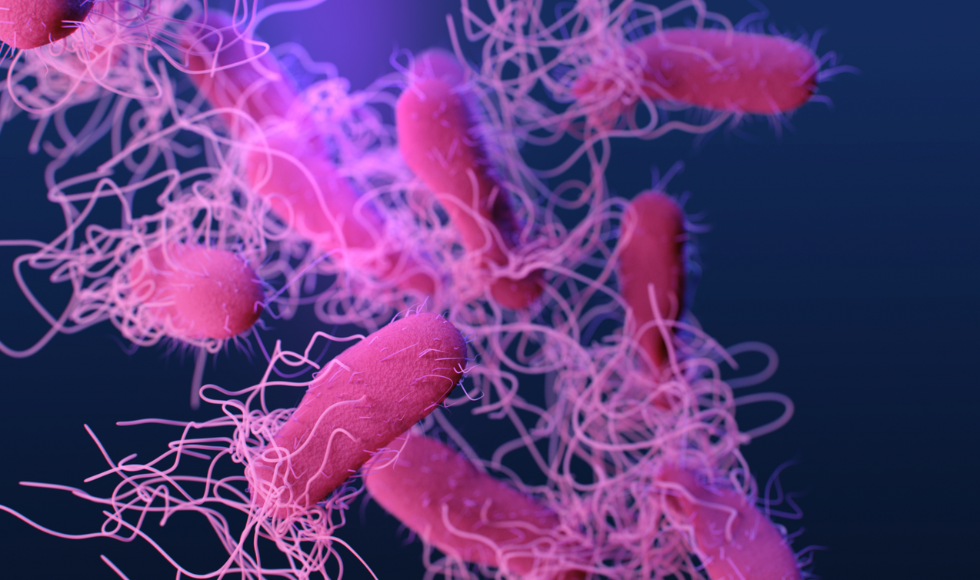Expert Brian Coombes on what you need to know about Salmonella

BY Blake Dillon
November 20, 2023
The spread of extensively drug-resistant Salmonella in Canada has prompted serious public health concern.
The outbreak, which has now spread across six provinces and infected at least 40 people, is being closely monitored by the Public Health Agency of Canada, according to an advisory.

Brian Coombes, chair of McMaster’s department of Biochemistry and Biomedical Sciences and a member of the Michael G. DeGroote Institute for Infectious Disease Research, says that while Salmonella itself is a concerning pathogen, it is the drug-resistant nature of the current outbreak that is sounding alarms.
“This particular strain is extensively drug-resistant, which means it is resistant to almost all clinically used antibiotics,” Coombes explains. “In a case like this, treatment options are really quite limited.”
The Coombes Lab, which also supports initiatives at McMaster’s Global Nexus School for Pandemic Prevention and Response, has a long history of studying Salmonella. In fact, his team is currently screening for chemical matter that could lead to new therapies for a drug-resistant strain of Salmonella associated with invasive bloodstream infections in Africa.
Here, Coombes gives a 101 on the ubiquitous, disease-causing bacteria and offers tips to keep you safe from infection.
What is Salmonella?
Salmonella is a genus of bacteria that typically infects the gastrointestinal tract of many different mammals, including humans. It is generally associated with food-borne illness, as it is very common in poultry and other animals used for food production.
How do people encounter Salmonella?
Handling raw food, especially meat products, is perhaps the greatest risk for Salmonella infection. These bacteria can live in animals that we raise for food production without causing significant signs of illness, so food producers often won’t know their animals are sick.
As well, Salmonella can contaminate food at virtually any point during the food production process, so it’s not necessarily sick animals that ultimately lead to human infection. For example, contamination could happen at a processing plant or during packaging processes.
Also, these bacteria can contaminate foods that we don’t necessarily cook, like lettuce and vegetable products. That’s why it’s essential that care is taken when handling all food products.
Salmonella can also spread from person to person. Enteric bacteria, like Salmonella, often cause symptoms like diarrhea. And while diarrhea is a symptom of the infection, it is also a process that bacteria have evolved to induce in order to help them spread from one host to another. So, by actively inducing inflammation in the gut, which leads to diarrhea, one person can expel millions of bacteria that can then contaminate bedding, clothing, door handles, and other items that other people might come into contact with. Because of this, Salmonella is very easily transmitted from person to person.
What are some common symptoms to watch for, and when should you see a doctor?
Salmonella typically causes gastrointestinal symptoms, including cramping, nausea, diarrhea, and vomiting. Generally, your body can handle the infection — you’ll likely feel sick for about two or three days, but you’ll often fully recover within a week or so without much medical intervention.
If symptoms persist beyond four days without signs of improvement, a doctor should be seen. They can prescribe antibiotics to help resolve severe illness.
Because regular symptoms include diarrhea and vomiting, Salmonella infection can lead to massive amounts of water loss. So, people whose symptoms are not resolving are at risk of dehydration, which can complicate things further.
What treatment options are available for Salmonella?
If you seek medical care for a suspected case of Salmonella, they will likely take either a stool sample or a swab and send it off to a clinical microbiology lab, where they can confirm what you’re infected with. When the results come in, they can perform antimicrobial susceptibility testing to determine which antibiotic would be most effective against the particular strain that you’re infected with. That process can take a long time, though, so oftentimes clinicians will prescribe a broad-spectrum antibiotic, which can help with recovery.
In some cases, however, the bacteria causing the infection is so extensively drug resistant that all but one or two classes of antibiotics will fail. And it’s not always the case that those drugs that should work will be available or approved for use in Canada.
As such, prevention is really the best medicine for bacteria like Salmonella.
What can people do to protect themselves from Salmonella?
A lot of Salmonella prevention comes down to having good personal and food hygiene. This means strict handwashing and ensuring that you don’t cross-contaminate utensils or other food-prep instruments. Handwashing during food preparation is particularly important, but you should also wash your hands when you return from public places or use the restroom.
Who is most at risk of Salmonella infection?
Salmonella can infect anybody, and mostly everybody who is infected will exhibit symptoms — it’s very indiscriminate in that way.
That said, children under five years old are often associated with Salmonella outbreaks. This is for a few reasons. First, it’s because kids are simply harder to keep clean — they don’t wash their hands the same way or as often as adults do, they often have their hands in and around their mouths, and they crawl and play on the floor. They have a very heavy reliance on adults to look after their hygiene for them. As well, young kids have immune systems that are not as well-trained as those of adults. Their immune systems just haven’t seen as many things, so they can be hyper-reactive or in some cases slow to react to infections.
Finally, kids are just much smaller than adults and therefore don’t have as much fluids as adults do, so infections that produce symptoms such as vomiting and diarrhea leave them more prone to dehydration.


